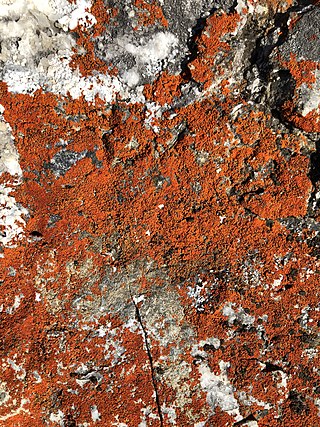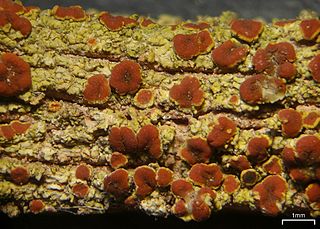Neobrownliella brownlieae is a species of saxicolous (rock-dwelling), crustose lichen in the family Teloschistaceae. It is widely distributed in Australia.

Flavoplaca is a genus of crust-like or scaly lichens in the family Teloschistaceae. It has 28 species with a mostly Northern Hemisphere distribution.

Igneoplaca is a genus in the subfamily Xanthorioideae of the family Teloschistaceae. It contains a single species, the crustose lichen Igneoplaca ignea.
Huneckia is a genus of crustose lichens in the subfamily Caloplacoideae of the family Teloschistaceae. It has four species.
Neobrownliella is a genus of crustose lichens in the subfamily Teloschistoideae of the family Teloschistaceae. It has five species. The genus was circumscribed in 2015 by lichenologists Sergey Kondratyuk, Jack Elix, Ingvar Kärnefelt, and Arne Thell, with Neobrownliella brownlieae assigned as the type species. It is a segregate of the large genus Caloplaca. Characteristics of Neobrownliella include a thallus that is continuous or areolate, the presence of anthraquinones as lichen products, a cortical layer with a palisade paraplectenchyma, and the lack of a thick palisade cortical layer on the underside of the thalline exciple. Two species were included in the original circumscription of the genus; an additional three species were added in 2020.
Tassiloa is a genus of lichen-forming fungi in the family Teloschistaceae. It has two species.

Opeltia is a genus of lichen-forming fungi in the family Teloschistaceae. It has four species of corticolous (bark-dwelling), crustose lichens.
Cerothallia yarraensis is a species of corticolous (bark-dwelling), crustose lichen in the family Teloschistaceae. Found in Australia, it was formally described as a new species in 2009 by lichenologists Sergey Kondratyuk and Ingvar Kärnefelt, as Caloplaca yarraensis. Kondratyuk and colleagues transferred it to the genus Cerothallia in 2014.
Marchantiana is a genus of lichen-forming fungi in the family Teloschistaceae. It contains seven species of corticolous (bark-dwelling), crustose lichens that occur in the Southern Hemisphere.
Verrucoplaca is a monotypic fungal genus in the family Teloschistaceae. It contains the single species Verrucoplaca verruculifera, a widely distributed saxicolous (rock-dwelling), crustose lichen that grows on coastal rocks.
Eilifdahlia is a genus of lichen-forming fungi in the family Teloschistaceae. It contains three species of corticolous (bark-dwelling), crustose lichens that occur in the Southern Hemisphere.
Filsoniana rexfilsonii is a species of saxicolous (rock-dwelling), crustose lichen in the family Teloschistaceae. Found in Australia, it was formally described as a new species in 2007. The thallus of Filsoniana rexfilsonii comprises brownish-orange squamules each hosting one to four reproductive structures.
Neobrownliella montisfracti is a species of saxicolous (rock-dwelling), crustose lichen in the family Teloschistaceae. It is found in Australia. The small lichen has dull pink to grey areoles, characterised by completely immersed, reddish to pink-brown apothecia and lacking soredia and isidia. Its areoles are closely pressed against the substrate, with the apothecia containing small, elongated ascospores and narrowly rod-shaped conidia.
Sirenophila cliffwetmorei is a species of saxicolous (rock-dwelling), crustose lichen in the family Teloschistaceae. It is found in Australia. Its thallus can reach up to 1 centimetre in width, has a whitish to whitish-grey colour, and is very thin, sometimes almost merging with the substrate, and has paler edges with a darker grey centre. Its numerous tiny apothecia give the thallus a yellow-orange appearance.
Caloplaca kiewkaensis is a species of bark- and wood-dwelling crustose lichen in the family Teloschistaceae. Described as a new species in 2011, this lichen is found in the Far East region of Russia, specifically within Primorsky Krai.
Franwilsia bastowii is a species of ramicolous (twig-dwelling), crustose lichen in the family Teloschistaceae. Found in Australia, it was formally described as a new species in 2009 by lichenologists Sergey Kondratyuk and Ingvar Kärnefelt. It was transferred to the genus Franwilsia in 2014. The species epithet bastowii honours the Scottish naturalist Richard Austin Bastow, who collected the type specimen in Mornington in 1901. The lichen is known to occur in Western Australia, South Australia, and Victoria, where it grows on the twigs of various shrubs and trees.
Kaernefia kaernefeltii is a species of saxicolous (rock-dwelling), crustose lichen in the family Teloschistaceae. It is widely distributed in Australia.
Oxneriopsis is a genus of lichen-forming fungi in the family Teloschistaceae. It has four species of corticolous (bark-dwelling), crustose lichens.
Lazarenkoiopsis is a single-species fungal genus in the family Teloschistaceae. It contains Lazarenkoiopsis ussuriensis, a corticolous (bark-dwelling), crustose lichen species found in the Russian Far East.
Elixjohnia jackelixii is a species of saxicolous (rock-dwelling), crustose lichen in the family Teloschistaceae. It is found in Australia and New Zealand. The lichen is characterised by its unique multilayered appearance with outer sterile rings that are brownish or greenish-yellow and inner areoles that are whitish, yellowish, or greyish, often cracked to reveal the medulla underneath. Its fruiting bodies, or apothecia, are typically attached directly to the thallus and vary in colour and shape.


